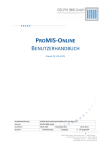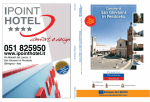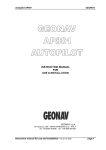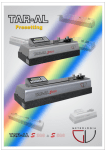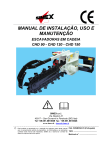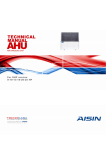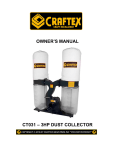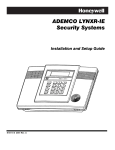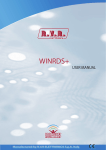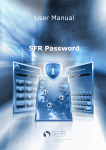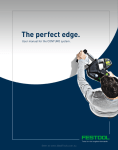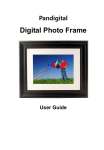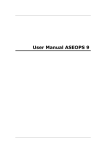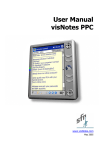Download Optimization Technologies for Cutting
Transcript
Optimization Technologies for Cutting NC-Way 1.1 User’s Guide OPTIMA SOFTWARE OPTIMA S.r.l. Via Vespucci, 4 • 40017 San Giovanni in Persiceto - BO - Italy Phone +39 051 826336 • Fax +39 051 825182 Internet: www.optima.it E-mail: [email protected] Copyright © 2007-2009 Optima S.r.l. All rights reserved The company OPTIMA S.r.l. declines any liability concerning this documentation, included any warranty of sale and suitability for special purposes. The company OPTIMA S.r.l. is not responsible for possible mistakes contained in this documentation, or casual damages occurring during working or due to the use of this package. No part of this handbook may be reproduced in any form or by any means or translated into any other languages without the express written permission of OPTIMA S.r.l. Information in this handbook is subject to change without notice. This handbook refers to the whole Optima range of products for processing and working flat surfaces. Some parts of this handbook refer to a specific product only and are to be considered if corresponding to the type and level of installation purchased. OPTIMA S.r.l. declines any liability concerning a wrong interpretation thereof. The registered marks and trademarks of the products mentioned therein are the property of their respective owners. Table of Contents 0 - INTRODUCTION ............................................................................. 4 Welcome ............................................................................................................. 4 Main Features...................................................................................................... 5 Data Import ................................................................................................................. 5 Display ........................................................................................................................ 5 CNC Connection ......................................................................................................... 5 Cutting Cycles ............................................................................................................. 5 Hardware Requirements ...................................................................................... 6 Minimum Requirements for NC-Way .......................................................................... 6 Recommended Requirements for NC-Way ................................................................. 6 Installation ........................................................................................................... 7 Connecting the Hardware Security Key ...................................................................... 7 Installing NC-Way ....................................................................................................... 7 Registering NC-Way ................................................................................................... 7 Folder and File Structure ..................................................................................... 8 Folders .......................................................................................................................8 CNC ............................................................................................................................ 8 DATA .......................................................................................................................... 8 DATA.DEF .................................................................................................................. 8 M.R ............................................................................................................................. 8 OPTIMSG ................................................................................................................... 8 SHAPE (Optional) ....................................................................................................... 8 Files ...........................................................................................................................9 Config.ini ..................................................................................................................... 9 Macchine.ini ................................................................................................................ 9 Optima.ini.................................................................................................................... 9 Parco.ini ...................................................................................................................... 9 Reinstalling the program ...................................................................................... 9 1 - DESCRIPTION OF COMMANDS .................................................. 10 Main Window ..................................................................................................... 10 File Menu ........................................................................................................... 11 Open ....................................................................................................................... 11 Open Z01 File ......................................................................................................... 11 Setup ...................................................................................................................... 12 Environment / General .............................................................................................. 13 Environment / Path ................................................................................................... 15 Environment / Counters ............................................................................................ 16 Machines / General ................................................................................................... 16 Machines / Parameters ............................................................................................. 17 Machines / Serial ...................................................................................................... 18 Machines / Optimization ............................................................................................ 19 Machines / Post-Processor ....................................................................................... 20 Machines / Compatibility ........................................................................................... 21 Machines / Velocity ................................................................................................... 21 Machines / Additional Parameters ............................................................................ 22 Material Parameters ............................................................................................... 23 First Record .............................................................................................................. 23 Previous Page........................................................................................................... 23 Previous Record ....................................................................................................... 23 Next Record .............................................................................................................. 23 Next Page ................................................................................................................. 23 Last Record............................................................................................................... 24 Add Material .............................................................................................................. 24 Remove Material ....................................................................................................... 24 User’s Guide 2 Modify ....................................................................................................................... 24 Save.......................................................................................................................... 24 Undo ......................................................................................................................... 24 Refresh ..................................................................................................................... 24 Save Bookmark......................................................................................................... 24 Go To Bookmark ....................................................................................................... 24 Filter .......................................................................................................................... 24 Alarms Reset .......................................................................................................... 25 Execute ................................................................................................................... 25 Send to NC ............................................................................................................. 25 Exit .......................................................................................................................... 25 View Menu ......................................................................................................... 26 View Work Order in Grid Mode ............................................................................... 26 First Sheet .............................................................................................................. 26 Previous Sheet ....................................................................................................... 26 Next Sheet .............................................................................................................. 26 Last Sheet ............................................................................................................... 26 Previous Repetition ................................................................................................ 27 Next Repetition ....................................................................................................... 27 Show Alarms........................................................................................................... 27 Show Message ....................................................................................................... 27 Help Menu ......................................................................................................... 28 About ...................................................................................................................... 28 2 - DESCRIPTION OF THE WORK AREA .......................................... 29 Machine Status and Main Message ................................................................... 29 Information about the Optimization .................................................................... 30 Graphic Layout .................................................................................................. 31 Override............................................................................................................. 32 Info Grid............................................................................................................. 33 Lower Toolbar.................................................................................................... 34 Work Page .............................................................................................................. 34 Alarms and Journal ................................................................................................. 35 Machine Parameters .............................................................................................. 35 Machine CYCLES ................................................................................................... 36 Pressures................................................................................................................ 37 Send to NC ............................................................................................................. 38 Shape Scanner ....................................................................................................... 38 Status Bar .......................................................................................................... 38 3 - OPTIMA PRODUCTS .................................................................... 39 Software Utilization Agreement .......................................................................... 39 How To Contact Optima S.r.l. ............................................................................ 41 Post- Warranty Product Support Services .......................................................... 41 Suggestions & Comments ................................................................................. 42 User’s Guide 3 NC-Way 1.1 Introduction 0 0- INTRODUCTION This USER'S MANUAL is a step-by-step guide for using the standard version of NC-Way. It provides information about commands as they appear in the standard graphics interface supplied by Optima S.r.l. Welcome Congratulations for purchasing a program from OPTIMA S.r.l. The program NC-Way is a useful reference for the entry, the optimization and the management of work orders for materials to be cut. This package has been designed after many years of work, co-operation and experience in the relevant field by skilled engineers always attentive to the problems of firms. All procedures have been made fully automatic and self-guided in order to allow even the less experienced users to learn the various functions of the program easily. NC-Way has been entirely developed at 32 bits on the Windows XP and Vista operating system. It has therefore all technical features of this operating system, thus being totally compatible with it. Any peripheral or pointing system, such as printers and mice, supported by Windows XP and Vista are automatically compatible with NC-Way. User’s Guide 4 NC-Way 1.1 Main Features NC-Way is based on a computerized workstation located on machine board, where all control functions for the interaction between system and cutting table are performed. This workstation allows you to perform all functions necessary for entering data, optimizing and cutting work orders, as well as acquiring data from optimizations performed in the office with OPTIMA or OPTIMA compatible systems. NC-Way offers various functions, among which: Data Import NC-Way system can import data of work orders previously optimized in the office, or - if entirely installed on the computer located on machine board - it can be directly interfaced with the main optimization system and make the most of its features. NC-Way is also capable of importing optimized or nonoptimized data generated by non-Optima systems. As these functions are OPTIONAL, for further information on such systems contact the Optima sales structure or your dealers. Display The display on machine board of the n system allows the complete control over cutting activities. The user is guided through each processing stage, as the software indicates sequence and type of cut to be performed and even how pieces located on the table are to be moved. NC-Way allows also displaying NC and PLC messages and warnings. CNC Connection NC-Way Is interfaced through a serial link with the cutting plant for the transmission of data concerning the machine positioning. Cutting Cycles NC-Way program allow to manage settings and operatively of each machine in an easy and flexible way. Cycles and NC Memory address can be easily changed trough the IOMAP setting. User’s Guide 5 NC-Way 1.1 Hardware Requirements The program runs on all IBM compatible computers equipped with the Windows XP Home and Professional operating system, when properly installed and working. The microprocessor and the RAM must be those required by the operating system installed. The video display card shall be an SVGA and the required resolution for correctly displaying all program menus SHALL be set at least to 1024 x 768 with 65,000 colors and small characters. We also recommend setting the Windows Taskbar to hide automatically in order to display data in the NC-Way status bar. The space available on the hard disk should be of at least 1 GB. Minimum Requirements for NC-Way Microsoft WINDOWS XP Home Edition. Personal computer equipped with an Intel PENTIUM III processor or higher. 512 MB or more of RAM memory. 1 GB of available space on the hard disk. 1 3 ½ floppy disk drive. 1 CD-Rom drive. SVGA display (1024x768). Mouse and keyboard. USB port to be used to connect the hardware security key of the program. Internet Explorer 6 or higher. Recommended Requirements for NC-Way Microsoft WINDOWS XP Professional SP2 Personal computer equipped with an Intel PENTIUM IV processor. 1 GB or more of RAM memory. 10 GB of available space on the hard disk. 1 3 ½ floppy disk drive. 1 CD-Rom drive. SVGA display (1280x1024). Mouse and keyboard. USB port to be used to connect the hardware security key of the program. Internet Explorer 6 or higher. Should the technical features of your computer not correspond to those above, or should you have any doubts about the required minimum configuration, do not hesitate to contact the customers’ department of OPTIMA S.r.l. for further details on the subject. User’s Guide 6 NC-Way 1.1 Installation The installing procedure is very easy as it is fully automatic and self-guided. No particular knowledge of the operating system is required to perform it properly. Connecting the Hardware Security Key Before installing the program, connect the hardware security key. To do so, plug it into the parallel port or into the USB port (depending on the kind of key you have). If you have a parallel port key first unplug the printer cable from your computer, then insert the key and plug the printer cable into the back of the hardware security key. If the printer available is not a network printer the use of a second parallel port (LPT2) is recommended for the connection of the hardware security key. This allows you to execute any program function even during printing, which is when the parallel port is busy (printing under way). In some cases printing may be interrupted. NOTE: The optimization program works only with the right hardware security key. Should the hardware security key be altered, the concession of the program utilization license will be immediately withdrawn. Installing NC-Way Installing NC-Way is the same as installing any other program for Windows, i.e. synthetically: 1. Insert the CD in the CD-ROM drive. 2. The autorun window opens (if the autorun feature is disabled, open My Computer and double-click on the CD drive unit). 3. Install the hardware security key drivers so that the key is properly detected. 4. Install NC-Way and follow the instructions displayed on the screen. Registering NC-Way Registering your program (through the registration card attached to this manual) entitles you to receive information on future updates, to access the Optima Technical Assistance Service and to have the product repaired or replaced in case of accidental damage. To register your program simply fill in the registration card and send it to Optima S.r.l. User’s Guide 7 NC-Way 1.1 Folder and File Structure The Opty-Way folder contains a large number of files and folders. Knowing their functions can be very useful in many cases and, above all, when reinstalling the program to avoid losing the work already completed or the previous parameter settings. Only those files and folders considered useful for you will be described below. Folders CNC This folder contains the files transmitted to the cutting and bending machines. These are the files sent directly to the path specified in the corresponding machine setting. Files are divided into subfolders. DATA This folder contains the sheet stock database and IOMAP settings. DATA.DEF This folder contains the stock database template. M.R This folder contains the r01 files of any completed optimizations. These files can be viewed using NC-Way. OPTIMSG This folder contains the files to translate the program into different languages. SHAPE (Optional) This folder contains the shapes in the .SAG format used in optimizations. User’s Guide 8 NC-Way 1.1 Files Config.ini This file contains settings relating to supported units of measurement, languages and digitizers. Macchine.ini This file contains all the cutting machines supported by the program and the relevant default parameters. Optima.ini This file contains all the program settings. Flags activated inside the optimization window, for example, are stored here. Parco.ini This file contains the machine characteristics configured in the setup. All cutting and bending machines used are saved in this file. Reinstalling the program To reinstall the program, do the following: Rename the Opty-Way folder as Opty-Way_OLD. Install the program. Copy the following folders from the old program folder: CNC; DATA; M.R; SHAPE. In addition to the following files: Config.ini; Optima.ini; Parco.ini; and .lab files created or modified by using Label-Way. User’s Guide 9 NC-Way 1.1 Chapter 1 1- DESCRIPTION OF COMMANDS Main Window When starting the NC-Way program for the first time a window like the one below appears: NOTE: This window might have fewer active features depending on the type of cutting table used. Manuale d’uso 10 NC-Way 1.1 File Menu From this menu you can set all the main program parameters. You can define the machine configuration and the data related to the current cutting order. Open Allows you to acquire cutting data to be optimized or cutting data of a previously optimized work order. This file must have been previously generated by an OPTIMA or OPTIMA compatible application, if available in the version being used. Toolbar File Menu Open Shortcut Key Ctrl+O Open Z01 File Allows you to open the files Z01 created by other Optima systems. Toolbar Manuale d’uso File Menu Open Z01 File Shortcut Key Ctrl+Z 11 NC-Way 1.1 Setup Allows you to set the main program data, such as the language, the unit of measurement and the machine to use in the optimizations. Toolbar File Menu Setup Shortcut Key Shift+Ctrl+F2 The access to the "Setup" menu is protected by means of a password to avoid an improper use of it. If you omit the password, you can only display the configuration, but you cannot make changes. If you enter the correct password you can modify the configuration. The password to this menu corresponds to your hardware security key number (you’ll find this number in the password request screen next to the Serial No.) proceeded by the number 10. For instance, if the number indicated on your hardware security key is 1000, your password will be 101000. When the Setup is opened, the tree structure of customizable settings is displayed on the left. Click on the desired option to access the setting modification page. Manuale d’uso 12 NC-Way 1.1 Environment / General User: Allows you to change the user name assigned to the customer, which will be shown in the various packages. Language: Allows you to choose the program language. All programs supplied by Optima S.r.l. will use the language set in this field. Languages available are: Italian English French Spanish German Portuguese Russian Simplified Chinese Traditional Chinese Polish Korean Hungarian Dutch To select a language, simply click on the button that displays the list of languages. NOTE: After choosing the desired language, restart the program so that all fields will be correctly displayed. Default U.M.: Allows you to set the default unit of measurement. Units of measurement available are: Millimeters Centimeters U.S Inches Taiwan Foot U.S Inches Fractions Tenth of millimeters Taiwan Inches U.S Inches CNC CNC Taiwan Inches Manuale d’uso 13 NC-Way 1.1 1/1000 of U.S. Inches Hundredth of Millimeters The second pull-down menu is used to define the internal unit of measurement of the program. IMPORTANT: You must modify the unit of measurement from this second pull-down menu ONLY the first time you start the program. Modifying this parameter later leads to a malfunctioning of the program, which will not be able to recognize all the previously entered data. NOTE: Choosing one option or the other will not compromise the use of any of the units of measurements of the program. You will be able to use millimeters and inches (as well as their multiples and submultiples) regardless of the option you chose. However, it should be noted that using the internal unit of measurement and the default unit of measurement associatively avoids approximation errors. Configure UM: Allows you to select the unit of measurement to be customized. Linear Postfix: Is a code, necessary for identifying the unit of measurement used. This code is automatically added when the values you enter refer to the default unit of measurement. It is instead to be specified when the value you enter refers to a different unit of measurement Area Postfix: Indicates the code necessary for identifying the unit of measurement used for calculating surface areas. Weight Postfix: Indicates the code necessary for identifying the unit of measurement used for calculating weight. Linear Conversion Factor: Indicates the conversion factor, with respect to the unit of measurement adopted by the optimization program, i.e. millimeters, necessary to convert the input data and to make it usable by the optimization program. Area Conversion Factor: Indicates the conversion factor, with respect to the unit of measurement adopted by the optimization program, i.e. square meters, necessary to convert input data and to print calculated surface areas correctly. Weight Conversion Factor: Indicates the conversion factor, with respect to the inner measurement unit adopted by the optimization program, i.e. kilograms, necessary to convert entered data and to print weights correctly. Fractions / Decimals: Allows you to specify whether decimal or fractional values are used after the integer in the unit of measurement you enter. Fractional Precision: Allows you to specify the highest denominator accepted, if fractions were selected. Number of Decimals: Allows you to specify the required maximum number of decimals. It is active only if you set Decimals in the Fractions/Decimals field. Manuale d’uso 14 NC-Way 1.1 Using different units of measurement The program automatically uses the unit of measurement you set in the Setup. You can, however, specify a different unit of measurement for each entry, by indicating the relevant postfix, if required. A postfix is a code that defines the unit of measurement to be used and is to be entered right after the piece dimensions. When the desired unit of measurement is different from the default postfix, it is to be specified in all fields requiring it. Postfixes and thus units of measurement available are as follows: mm = Millimeters; cm = Centimeters; dmm = Tenth of millimeters; cmm = Hundredth of Millimeters; in = U.S Inches; inf = U.S Inches Fractions; inB = U.S Inches CNC; tin = 1/1000 of U.S. Inches; tf = Taiwan Foot; ti = Taiwan Inches; tiB = CNC Taiwan Inches; You can even create new units of measurement and thus postfixes. Environment / Path M.R Folder: Identifies the path in which M.R files are saved. These contain the data pertaining to each optimization saved. Sag Shape Folder: Identifies the path in which .sag shapes used by the program are saved. Machine List File: Identifies the path in which the Parco.ini file is saved. This file contains the data pertaining to the selected machine. Ops Parametric Shape Folder: Identifies the path that contains the files of the parametric shapes to be used. Sag Shape Library Folder: Identifies the path in which the parametric shape prototypes created by the user are saved. TXT File Label Folder: Identifies the path in which the files created by the Print Labels on File option are saved. Manuale d’uso 15 NC-Way 1.1 Environment / Counters Automatic Work Order Name: Enables the automatic work order name. This will be a progressive number between the Maximum and Minimum values entered (-1 for no limits). Automatic Shape Name: When a shape is saved from the program GeoWay, a shape name, i.e. a number incremented by one with each save operation, is presented automatically. Numbers between the entered Maximum and Minimum values will be used (-1 for no limits). Cutting Plan Progressive: Enables the automatic numbering of cutting plans, if allowed by the machine. Numbers between the entered Maximum and Minimum values will be used (-1 for no limits). Machines / General NOTE: Not all the machines that can be used with our program support all the features described on the following pages. Some of the fields may be deactivated or, although activated, may not produce the results described. Cutting Line Name: This description is very important, as it identifies cutting line the optimization is intended for. It can accept up to alphanumeric characters. You cannot enter the same description different cutting lines. Manufacturer: Identifies the manufacturer of the cutting table. Click on list box to display the list of the manufacturers supported. Manuale d’uso the 32 for the 16 NC-Way 1.1 Machine Model: Allows you to select the desired cutting table model among those of the manufacturer you selected. Numerical Control: Allows you to select the Numerical Control installed on your machine, in case more NCs are listed. Numerical Control U.M.: Allows you to set the unit of measurement used by your numerical control. Number of Decimals: Allows you to set the number of decimals to be saved in the file generated by the optimization program and sent to the Numerical Control. Machine Code: Code that identifies each machine inside the list of machines supported by the program. Destination: Allows you to define the destination path in case the file is sent via Path. The default path is A:\ but you can change it with a path on the local HD or a remote computer. Sheet Zero Position: Indicates where the zero point of the sheet is to be located on the cutting table and thus where the cut is to be started. Optimization Transmission Mode: Allows you to define how to send optimized work orders. The "Full Work Order" option sends the entire file necessary to cut the entire optimization at one time. Instead, the "Sheet by Sheet" option sends one sheet at a time. Sheets Sorting: Allows you to choose the order in which sheets (as defined in NC-Way) are printed and sent to the cutting system. Machines / Parameters Max Sheet X/Y Dimensions: Max. sheet dimensions allowed when entering data into the stock or pieces. X/Y Parking: Refers to the parking value, if required, to which the cutting head is to be moved after cutting a sheet. X/Y Offset: Indicates the translation of the cutting dimensions by a certain value (it translates the zero point by the desired value). Double Zero: Allows you to indicate the second reference for the Cutting Table used when mirroring the sheet in the laminated glass cutting. X1, X2, X3 Break-up Bars: Allows you to enter up to max. 3 dimensions along X, corresponding to the positions of the breakout bars of the machine. These bars are displayed when using the editor functions and allow the operator to move pieces or groups of pieces so as to make them coincide with the position of the machine bars, and thus to facilitate breakout. Set the value to 0 so as not to display them. Y1, Y2 Break-up Bars: The same as X1, X2, X3 Break-up Bars, but referred to the positions of breakout bars along Y. Max. X/Y-Crosscut Exit: Indicates the permissible maximum length of a cut going out of a grid of pieces when the Join Waste option is activated. Waste areas that are larger than this value are joined, whereas smaller waste areas are split to make sheet break-out easier. Safety Distance From Sheet Edge: Distance kept by the head during positioning on the sheet edge. It is used to prevent the head from exiting the glass during cutting if the glass edge is damaged. Manuale d’uso 17 NC-Way 1.1 Perpendicular Cut Distance: Refers to the safety dimension for cuts. Each cut is automatically started after and stopped before another cut by the value set for this parameter, so as to prevent the cut from going beyond or touching the next perpendicular one in case of mechanical compensations. Machines / Serial Select the machine you wish to use. Even though all the values are set automatically based on the specifications supplied by the machine manufacturer, you can modify them at any time. Manuale d’uso 18 NC-Way 1.1 Machines / Optimization No. Cutting Levels: Each cut generated by the optimization program has its own well-defined features. The program can manage up to 5 different types of cuts, namely: X Cut: Vertical cut dividing a sheet into two halves along the short side (usually called Crosscut). Y Cut: Horizontal cut defined by 2 X Cuts, i.e., passing between two X cuts. Z Cut: Vertical cut passing between two Y cuts. V Cut: Horizontal cut passing between two Z cuts. W Cut: Vertical cut passing between two V cuts. Q Cut: Horizontal cut passing between two W cuts. R Cut: Vertical cut passing between two Q cuts. It is thus evident that each higher-level cut leads to a more complex breakout of sheets. Possible combinations may be reduced to make cutting plan break-out easier. Max. No. of Crosscuts: Refers to the max. number of crosscuts that can be generated in a cutting plan during optimization. Tool Management: Allows you to enable/disable the use of a tool (such as a disc) during glass cutting. Tool Thickness: Refers to the thickness of the tool to be used to cut the optimized sheet. For a thickness over 0, piece dimensions are increased, so that the material removed during cutting (e.g. by a saw) does not affect the dimensions of the finished piece. X/Y Tool Exit: Is useful when disk saws are used to cut the material, in order to take into account the particular type of cutting performed by the tool. Pieces are grouped in "blocks" having a certain distance one from the other so that pieces are not damaged by the tool. This field is displayed by default in the tools table of the optimization procedure. Manuale d’uso 19 NC-Way 1.1 Machines / Post-Processor Auto Send: Enables the automatic transmission when pressing the Send button. You are not prompted to press OK to confirm transmission. Pre-Processor Path: Indicates the path of an external executable that will be started before an optimization to perform an external processing. Post-Processor Path: Indicates the path of an external executable that will be started after an optimization to perform an external processing. Enable Shapes: If enabled, shapes and cuts (if possible) are sent to the machine. Shape Cutting Priority: If enabled, shapes (if present) are cut before the corresponding bounding boxes. Check Piece Compatibility: Checks work order input data and compares it with the data in "Piece Data" for compatibility with the set limits. Keep Shape Name: Exclusive function for some cutting systems. It allows you to keep the number assigned as the name of the shape. If inactive, shapes in the cutting order are numbered automatically and progressively. Optimize Shapes: Calculates the best tool path to speed up the cutting operation. Optimize Shapes Inside: Calculates the best head path for shapes and thus for any holes inside them and the corresponding head up movements. Optimize All Shapes: Calculates the best head movement between one shape and the other to speed up the cutting operation. Join Offcuts: If enabled, offcut areas are joined automatically (when possible). In a grid of pieces, only the last piece goes out upwards. All other crosscuts are not made. This makes cutting more complex but quicker. Enable Monodirectional Cuts: If active, cuts are all made in one direction. This slows down the cutting operation, but reduces the error caused by the rotation of the head. It also increases the cutting performance of systems equipped with a PVB or vinyl cutting blade. Enable CNC Info: Creates a text file with the information about the optimization results. Glass Thickness Management: Enables or disables the transmission of the glass thickness value. Loader Management: This feature is available only for some systems. It creates an additional file with the sequence of sheets and the corresponding positions on the rack the automatic loader must load to. Enable Lateral Cutting Exit on Last Sheet: Allows the optimizer to let cuts exit laterally, if the sheet side edge is closer than the upper edge. Manuale d’uso 20 NC-Way 1.1 Enable Cutting Velocity Management: Enables the machine speed changes when changing from straight to shape cutting or vice versa. Cuts as Displayed: If the table zero point is not the "Bottom left" corner you can save the dimensions of cuts in the same way as they are displayed on the screen. This feature is active only for some machine models. Normally, this is managed by the Numerical Control of the cutting table. Enable Labels: Allows you to send to the cutting table the data pertaining to the labels that are printed and applied onto glass items automatically. This option is active only for some special machines. Use Label-Way to select the type of label to use for each work order. Machines / Compatibility Minimum Box X / Y Side: Minimum dimension allowed for the X and Y sides. Maximum Box X / Y Side: Maximum dimension allowed for the X and Y sides. Minimum Length: Minimum length of the profile. Maximum Length: Maximum length of the profile. Minimum Angle: Minimum working angle allowed by the machine. Maximum Angle: Maximum working angle allowed by the machine. Minimum Radius: Minimum bending radius allowed by the machine. Maximum Radius: Maximum bending radius allowed by the machine. Tolerance Angle: Refers to the angle within which two entities of a shape must lie so that the head is not lifted. Machines / Velocity VC max - Max. Cutting Speed: Is the maximum cutting speed of the table. VC max S - Max Shape Cutting Speed: Is the maximum shape cutting speed of the table. VS max - Max. Movement Speed: Is the maximum speed of the table fast movement. AM - Movement Acceleration: Is the maximum acceleration of the table when moving. RotTim - Head Rotation Time: Is the time needed by the head to make a complete rotation. UpTime - Head Lifting Time: Is the time needed by the head to lift. DownTime - Head Lowering Time: Is the time needed by the head to lower. Manuale d’uso 21 NC-Way 1.1 Machines / Additional Parameters NOTE: This section may not be present depending on the type of machine set in the program. NC-Way Settings: Allows you to activate additional NC-Way settings. Low-E Grinding: Enables Low-E glass grinding also on the sides where no cutting is performed. Automatic Execution: Maintains the connection to the machine even when cutting options are changed. Manuale d’uso 22 NC-Way 1.1 Material Parameters Allows you to indicate the machine parameters to be used for every material. NOTE: This function is available only for enabled machines. Toolbar File Menu Material Parameters Shortcut Key Ctrl+Shift+P The top part of the screen has a set of buttons: First Record Moves the selection to the first record. Toolbar Previous Page Moves the record selection one page back. Toolbar Previous Record Moves the selection to the previous record. Toolbar Next Record Moves the selection to the next record. Toolbar Next Page Moves the record selection one page forward. Toolbar Manuale d’uso 23 NC-Way 1.1 Last Record Moves the selection to the last record. Toolbar Add Material Adds a material. Toolbar Remove Material Removes the selected material. Toolbar Modify Sets a table as editable. Toolbar Save Saves changes made. Toolbar Undo Undoes changes made. Toolbar Refresh Refreshes displayed data. Toolbar Save Bookmark Saves a bookmark in the grid. Toolbar Go To Bookmark Moves the selection to the previously set bookmark. Toolbar Filter Allows you to set a display filter for those materials that comply with the desired characteristics. Toolbar Manuale d’uso 24 NC-Way 1.1 Alarms Reset Allow to remove all Error Messages and Warning from the Alarms and Journal Page. Toolbar File Menu Alarms Reset Shortcut Key Ctrl+E Execute Activates/Deactivates the data transmission to the cutting installation numerical control. The system switches to the automatic mode to manage the communication with the cutting installation. Toolbar File Menu Execute Shortcut Key None NOTE: This is an additional program option. Send to NC Allow sending the Active Program to the Numeric Control. Toolbar File Menu Send to NC Shortcut Key None Transmission to the NC it’s allowed only when the specific Icon is available. In some situation, like when machine is performing axis movements, transmission is NOT allowed . N.B.: To remove program from the Numeric Control, usually, it’s possible by the pressure of General Emergency machine control box button. This operation, usually, also re-activate the Send to NC Icon. Exit Allow to exit from the NC-Way Program. Toolbar File Menu Exit Shortcut Key None When NC-Way is closed latest situation is automatically saved so, at next application start, system back to this point and work can continue from there. Manuale d’uso 25 NC-Way 1.1 View Menu This menu contains all the functions related to the display of the current optimization. View Work Order in Grid Mode Allows you to define the sheet data and graphics to be displayed on the screen (Grid Mode or Sheet Mode) Toolbar View Menu View Work Order in Grid Mode Shortcut Key None First Sheet Displays the first sheet of the optimization file. Toolbar View Menu First Sheet Shortcut Key Ctrl+Home Previous Sheet Displays the previous sheet. Toolbar View Menu Previous Sheet Shortcut Key Home Next Sheet Displays the subsequent sheet. Toolbar View Menu Next Sheet Shortcut Key End Last Sheet Displays the last sheet. Toolbar Manuale d’uso View Menu Last Sheet Shortcut Key Ctrl+End 26 NC-Way 1.1 Previous Repetition Change current sheet repetition to the previous one in case more than one is available. If the selected one is the First of the sheet automatically display the Previous sheet. Toolbar View Menu Previous Repetition Shortcut Key None Next Repetition Change current sheet repetition to the next one in case more than one is available. If the selected one is the Last of the sheet automatically display the Next sheet. Toolbar View Menu Next Repetition Shortcut Key None Show Alarms Allows you to display the Alarms existing on the machine NC on the Alarms and Journal Page. Toolbar View Menu Show Alarms Shortcut Key None NOTE: This window may be hidden depending on the type of machine used. Show Message Allows you to display the Messages existing on the machine NC on the Alarms and Journal Page. Toolbar View Menu Show Messages Shortcut Key None NOTE: This window may be hidden depending on the type of machine used. Manuale d’uso 27 NC-Way 1.1 Help Menu About Displays the program About window in which you can find the hardware security key number and the program version. Toolbar Help Menu About Shortcut Key Manuale d’uso 28 NC-Way 1.1 Chapter 2 2- DESCRIPTION OF THE WORK AREA The work area comprises: Menus (see Chapter 1 for a description of the single menus and menu commands) Upper Toolbar (see Chapter 1 for a description of the single menus and menu commands) Machine Status and Main Message Graphic Layout Information about Cutting Dimensions Info Grid Alarms Window Lower Toolbar Status Bar Machine Status and Main Message Allows you to display the machine connection status (on the left) and to display the Main Error Message or Warning Message of NC or PLC (on the right). Machine Status could be Automatic or Manual. In relation of the PLC Type some CYCLES will be available or not. Automatic or Manual Mode are usually selectable on the Cutting Table Control Panel. In Automatic Mode “Send to NC” Option is available. On this Machine Status it will also be possible to execute cutting programs. In Manual Mode, usually, CYCLES like Sizing, Head or Belts UP / DOWN ,Oil Open / Close will be available. Message visible on the Right side it’s usually the Most Important. For a complete view of all active Errors and Warning we recommend to use the specific “Alarms and Journal” Page. Manuale d'uso 29 NC-Way 1.1 Information about the Optimization This area displays the information about the open work order. File: Identifies the name of the temporary file in which the optimization is. Mat.: Type of glass used. Dimensions: Identifies the length and the width of the sheet. 1st Glass Thick.: Thickness of the first glass layer of a laminated glass unit. Plast. Thick.: Thickness of the plastic interlayer between the two layers of a laminated glass unit. 2nd Glass Thick.: Thickness of the second glass layer of a laminated glass unit. Pressure Up Cut: Pressure to cut the upper glass. Resistance Timer: Exposure time of the plastic film to resistance. Pressure Down Cut: Pressure to cut the lower glass. Repetitions: the first number refers to the total amount of sheets cut, including that being cut at the moment; the second number refers to the total amount of sheets cut (repetitions) using the current cutting plan, while the last number refers to the total amount of sheets to be cut according to the current cutting plan. In the example the first sheet is being cut, and that is the first “repetition” out of the two necessary (1:1/2) for cutting plan no. 1 of 4. Sheet No.: Number of the active cutting plan and number of the different cutting plans (each cutting plan may also be cut more times). In the example the first of 4 different cutting plans is being cut (1/4). This does not correspond to the total number of sheets to be cut, in case one or more cutting plans are to be repeated (cut more times). Mat .Type: Identifies the type of material associated with the code. NOTE: The "Pressure Up Cut", "Resistance Timer" and "Pressure Down Cut" fields are available only for those machines enabled to manage them. Manuale d'uso 30 NC-Way 1.1 Graphic Layout Graphic Layout is available in two main modes: Grid Mode Table Mode On the “Grid Mode” screen is divided in two sides: On the Left Side its available the “Actual Operation” that display the Cutting Layout currently processed by the numeric control. On the Right side is available the “Next Operation” that display the next Cutting Layout will be available once the Actual will be completed. On this Graphic Mode only the Sheets Layout it’s displayed and while cutting is performed head position is NOT graphically displayed (Trace Function). Data Displayed internally of each glass, or the used Measurement Units and the type of Sizes can be changed trough the NC-Way Setup. N.B.: On the above example Zero Table setting is “Lower Left” Manuale d'uso 31 NC-Way 1.1 On the “Table Mode” graphic area it’s displayed in one only window. On the “Table Mode” the full size of the cutting table layout is displayed according to the size of maximum sheet X and Y sizes of Setup of NC-Way. The graphic layout of the sheet is displayed by keeping real proportions. On this View Mode, when cutting table is working, TRACE Mode in ON. Trace Mode allow displaying the Head Position by reading the real X and Y axis position from the Numeric Control. N.B.: According to the Communication speed between NC-Way and Numeric Control and according to the refresh frequency of Axis Position by the PLC, cutting head cursor can have some delay. Override Allow to set, by perceptual value of the Maximum speed from the NC-Way Setup, the Cutting Table speed to be used for the current program. When NC-Way start Override Value is always set to “100” that means 100% of the Setup Speed calculated by the Numeric Control. Manuale d'uso 32 NC-Way 1.1 Info Grid On the Left side of the screen, divided by 5 Main Groups, all data related to the current program, are available. Work Order: Display Main Data of the Work Order sent to the Numeric Control so ready for Cutting. Data available are: Active Program: Display the name of the active program on the NC Memory. Active Optimization: Display the name of the active optimization on the NC Memory Active Sheet::Display the number of the active cutting plane on the NC Memory. Active Repetition: Display the number of the active repetition on the NC Memory. Axes Positions: Allow displaying data related to the position of axes, speed and pressure. X1: Display position of “X-axis Y1: Display position of “Y” axe B1: Display position of “R” axe C1: Display position of “C” axe P: Display Cutting Pressure Speed Override: Display de Override % speed Messages: On the Message Group is displayed messages related to the numeric control communication status and related to the execution of the program. Channel Status Program Status NC Info Manuale d'uso 33 NC-Way 1.1 Lower Toolbar This toolbar includes a variety of functions related to the cycles to be executed by the machine and related to the machine itself. NOTE: This window may be hidden depending on the type of machine used. Work Page Allow to Display the Graphic Layout that, according to the current setting, could be “Grid Mode” or “Table Mode”. Manuale d'uso 34 NC-Way 1.1 Alarms and Journal Allows you to display the Warning and Error alarm messages existing on the machine NC. NOTE: This window may be hidden depending on the type of machine used. Machine Parameters Allow to display and edit NC parameters and PLC parameters of the Machine available on the IOMAP. N.B.: List of available parameters and related Groups change according to the type of Numeric Control and Cutting Table options. Usually parameters are divided in 3 main groups: Sizing Vales: List of parameters used for the Sizing Cycle and to set up the Zero Point of the Machine. PLC Parameters: List of generics Machine and PLC Parameters Digitizing Parameters: Parameters used by the Laser digitizing system Manuale d'uso 35 NC-Way 1.1 Machine CYCLES Allow to display Machine CYCLES available on the IOMAP. N.B.: CYCLES List change according to the Machine Type and PLC CYCLES Available in Automatic Mode Stop: Stop execution of cutting on the position where the axis is. Cutting Head goes UP and OIL closed. Next Start allows CONTINUING from the Stop point up to the END of the current program. Simulate: Status ON / OFF. When ON Cutting Cycle is executed with the Head Up / Down Movement disabled. Step by Step: Status ON / OFF. When ON Cutting Cycle automatically Stop and the end of each ISO instruction. The next Start allows executing following instruction only. If disabled, at next Start program restart normally up to the end of the complete program. Parking: Allow to move X, Y and R axes to the Park position value entered on the Setup of NC-Way. CYCLES Available in Manual Mode Sizing Start the Sizing Cycle that usually is requested when machine start after Power Off and eventually after Main Emergency. Blowers: Status ON / OFF. Allow to start and stop the Blowers used to move glass over the carpet. Manuale d'uso 36 NC-Way 1.1 References: Allow to align sheet of glass on the right zero point position. Oil: Status ON / OFF. Allow to Open / Close cutting OIL Head: Status UP / DOWN. Allow to UP / Down Cutting Head. Transfer: Status ON / OFF. Allow to start and stop the Belt Transfer used to move load unload glass over the cutting table. Pressures Allow to Display and Edit Cutting Pressures according to the Glass Thickness. Values are in BAR. NC-Way allow to manage, according to the Glass Thickness, two different independent pressure value, one used when Straight Cutting is Performed, one used when Shape Cutting is Performed. Program already display all available Glass thickness so, usually, it’s just requested to edit available pressure values, anyway, system allow to remove existing records and to add new records on this grid. To add a new Record on the Grid press “INS” key. To remove one Record from the Grid press “CTRL + DEL” Manuale d'uso 37 NC-Way 1.1 Send to NC Allow sending active program to the Numeric Control Transmission to the NC it’s allowed only when the specific Icon is available. In some situation, like when machine is performing axis movements, transmission is NOT allowed. N.B.: To remove program from the Numeric Control, usually, it’s possible by the pressure of General Emergency machine control box button. This operation, usually, also re-activate the Send to NC Icon. Shape Scanner Allow to acquire a wood, glass, or paper template with laser digitizer. According to the type of Software, type of Numeric Control and type of Machine this function can be available or not. Usually system starts a kind of Macro that allows following the shape profile. Digitalized points will be available to CAD-Way program that will be able to make automatic geometrical shape construction (Shape Interpolation Function). Status Bar The program status bar shows the following information: Serial number of the program in use. This number is essential when technical assistance is needed. Unit of measurement set in the program. Language set in the program. Version of the program in use. This number is essential when technical assistance is needed. Machine set in the program. This number is essential when technical assistance is needed. Manuale d'uso 38 NC-Way 1.1 Chapter 3 3- OPTIMA PRODUCTS This Chapter describes terms and conditions of the Optima products license agreement, Product Support Services access and product registration modes. Software Utilization Agreement A) APPLICATION END-USER LICENSE AGREEMENT FOR OPTIMA SOFTWARE PRODUCTS AND LIMITED WARRANTY Read following terms and conditions carefully before opening this package. The use of this Software Product is subject to the terms of the following License. If you do not agree to the terms of this License, promptly return the unopened package for a full refund. BY OPENING THIS PACKAGE, YOU SIGNIFY THAT YOU HAVE READ THE OPTIMA LICENSE AGREEMENT AND ACCEPT ITS TERMS AND CONDITIONS. LICENSE AGREEMENT Against payment of a given amount for this Software Product OPTIMA S.R.L. grants the Customer a license to use the Product under the following terms: 1. The Product may be used on one computer only, as per the instructions on the handbook, which is an integral part of the Product itself. A separate license agreement and the payment of an additional amount are required for each computer on which the Product is used. 2. The Product may not be transferred, distributed, granted or sub licensed to a third party. 3. The Customer undertakes not to copy, modify, alter or adapt the Product either for its use or for a third party's use. The Product may not be copied, other than for archival purposes, for checking program errors or replacing faulty supports. Anyway all copies must bear the copyright of the original copy. 4. The Customer undertakes not to grant or transfer to a third party, in Italy and/or abroad, any work, product, object derived from the Product by translation, decompiling or disassembling, without the prior written permission of OPTIMA S.R.L. 5. The Customer undertakes, in case this License refers to a demo copy of the Product, to use it for demos, support and training to the end users and not for professional purposes, as well as not to grant it to a third party. 6. This license transfers the Customer no right, title or interest other than those expressly provided by this agreement and the Customer acknowledges that the Software is protected by the copyright laws. This Software Product may have been developed by an independent software supplier, who has copyrights and the other rights of property with respect to this Software Product. The Customer shall be liable to this independent supplier for any infringement of these rights. Manuale d'uso 39 NC-Way 1.1 7. OPTIMA S.R.L. has the right to immediately withdraw this license if the Customer infringes the terms of this agreement. In case of license withdrawal, the Customer shall either return OPTIMA S.R.L. all copies of the Product, or, if OPTIMA S.R.L. agrees to it, the Customer shall exhibit a certificate of destruction of all the copies of the Product. 8. Should the Customer have modified the Software Product or included it into any other software product, in case of license withdrawal the Customer shall alternatively remove the Software Product or any part of it from the modified program and return it to OPTIMA S.R.L., or, if OPTIMA S.R.L. agrees to it, the Customer shall exhibit a certificate of destruction of all the copies of the Product. 9. Should some of the provisions of this license be invalidated by any law, the rest of the agreement shall remain valid and binding upon the parties. 10. This license to use replaces any other previous agreement between the parties. All agreements, rights, engagements and promises contained herein are binding upon the parties and may not be transferred or granted by one party without the prior written permission of the opposite party. 11. If one party tolerates opposite party's infringements of the provisions of this license to use, it does not mean that it resigns its rights under this License. 12. All controversies arising out of the interpretation and execution of this agreement shall be submitted to an Arbitral Body made of three members, i.e. one representative appointed by each of the two parties and a third member, acting as the chairman of the Arbitral Body, appointed by mutual consent of the first two members, or, by default, by the Presiding Judge of the Court of Bologna upon request of the most diligent party. This Body shall judge according to the usual procedure or any other procedure it deems it suitable to adopt. LIMITED WARRANTY 1. OPTIMA S.R.L. warrants that for a period of 360 days from the date of purchase, this Product will correctly execute the program instructions, if properly installed on the personal computer specified on this package. OPTIMA S.R.L. does not warrant that the Software will work uninterruptedly and free from errors. Should this Software Product not be able to execute the program instructions during the warranty period, the Customer shall return OPTIMA S.R.L. the disks and the hardware and OPTIMA S.R.L. shall replace them. Should OPTIMA S.R.L. not be able to replace the material within a reasonable time, the Customer shall have the right to receive back the price paid, after returning OPTIMA S.R.L. the Product and all relevant copies. 2. OPTIMA S.R.L. disclaims all other warranties, either express or implied, with respect to this Product. OPTIMA S.R.L. disclaims specifically any warranties of merchantability or fitness for a particular purpose. 3. Remedies provided herein are the only remedies the Customer may make use of. In no event shall OPTIMA S.R.L. be liable for direct, indirect or other damages of any nature whatsoever suffered by the Customer. 4. OPTIMA S.R.L. may supply, at its exclusive option, technical support services for the Product, either directly or through its sales network. Manuale d'uso 40 NC-Way 1.1 How To Contact Optima S.r.l. Each and every program by Optima S.r.l. is covered by a warranty for twelve months from the date of purchase of the original software, as mentioned in the warranty clauses above. Whenever the customer needs technical support in relation to the correct working of the software purchased, the customer may contact Optima S.r.l. following these instructions: Complete the REGISTRATION CARD enclosed in this documentation in all its parts. Send the REGISTRATION CARD to Optima S.r.l., per fax to the no. +39 051 825182, or per e-mail to the address: [email protected]. IF THE SOFTWARE PRODUCT IS NOT REGISTERED, NO FORM OF TECHNICAL ASSISTANCE IS GUARANTEED BY OPTIMA FOR THE SOFTWARE PURCHASED. Once the software package purchased has been registered, the customer has the right to contact the Optima S.r.l. technical support department and receive - per phone or telecommunication - the proper support for the correct functioning of the software purchased. The technical support is provided in relation to the Optima S.r.l. software only. No technical support is provided about problems related to other software or hardware systems. Post- Warranty Product Support Services When the TWELVE-month warranty granted by Optima S.r.l. expires, the customer has no longer the right to access the technical support, via telephone or telecommunication. Optima S.r.l. places to its customers’ disposal a package of commercial solutions capable of granting the best support possible for its systems. These solutions are: THL Telephone Hot Line Service PUS Program Update and Support Service Signing these kinds of support agreement forms at the twelve-month warranty expiry is facultative, but surely recommendable for the correct functioning of the software purchased and above all to avoid troublesome and expensive production STOPS. For further information on support services, contact the Optima S.r.l. sales department or decentralized sales structures. Manuale d'uso 41 NC-Way 1.1 Suggestions & Comments Should you have any suggestions or comments on the software system you possess, please fill in this form and return it to Optima S.r.l., per fax to the no. +39 051 825182, or per e-mail to the address: [email protected], for the kind attention of the software development manager. We thank you in advance for the kind and effective cooperation. SERIAL NUMBER (HARDWARE SECURITY KEY NUMBER) PRODUCT NAME VERSION COMPANY NAME SIGNATURE COMMENTS Manuale d'uso 42











































